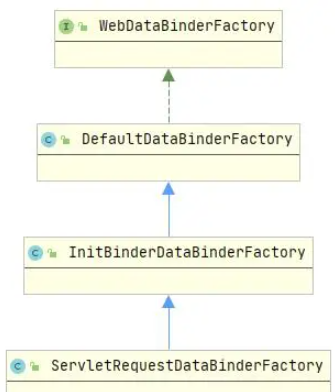您好,登錄后才能下訂單哦!
您好,登錄后才能下訂單哦!
這篇文章主要講解了“Spring @InitBinder注解如何使用”,文中的講解內容簡單清晰,易于學習與理解,下面請大家跟著小編的思路慢慢深入,一起來研究和學習“Spring @InitBinder注解如何使用”吧!
以前言中提到的字符串轉Date為例,對@InitBinder的使用進行說明。
@RestController
public class DateController {
private static final String SUCCESS = "success";
private static final String FAILED = "failed";
private final List<Date> dates = new ArrayList<>();
@RequestMapping(value = "/api/v1/date/add", method = RequestMethod.GET)
public ResponseEntity<String> addDate(@RequestParam("date") Date date) {
ResponseEntity<String> response;
try {
dates.add(date);
response = new ResponseEntity<>(SUCCESS, HttpStatus.OK);
} catch (Exception e) {
e.printStackTrace();
response = new ResponseEntity<>(FAILED, HttpStatus.INTERNAL_SERVER_ERROR);
}
return response;
}
}上面寫好了一個簡單的Controller,用于獲取Date并存儲。然后在單元測試中使用TestRestTemplate模擬客戶端向服務端發起請求,程序如下。
@ExtendWith(SpringExtension.class)
@SpringBootTest(webEnvironment = SpringBootTest.WebEnvironment.RANDOM_PORT)
class DateControllerTest {
@Autowired
private TestRestTemplate restTemplate;
@Test
void 測試Date字符串轉換為Date對象() {
ResponseEntity<String> response = restTemplate
.getForEntity("/api/v1/date/add?date=20200620", String.class);
assertThat(response.getStatusCodeValue(), is(HttpStatus.OK.value()));
}
}由于此時并沒有使用@InitBinder注解修飾的方法向WebDataBinder注冊CustomDateEditor對象,運行測試程序時斷言會無法通過,報錯會包含如下信息。
Failed to convert value of type 'java.lang.String' to required type 'java.util.Date'
由于無法將字符串轉換為Date,導致了參數類型不匹配的異常。
下面使用@ControllerAdvice注解和@InitBinder注解為WebDataBinder添加CustomDateEditor對象,使SpringMVC框架為我們實現字符串轉Date。
@ControllerAdvice
public class GlobalControllerAdvice {
@InitBinder
public void setDateEditor(WebDataBinder binder) {
binder.registerCustomEditor(Date.class,
new CustomDateEditor(new SimpleDateFormat("yyyyMMdd"), false));
}
}此時再執行測試程序,斷言通過。
小節:由@InitBinder注解修飾的方法返回值類型必須為void,入參必須為WebDataBinder對象實例。如果在@Controller注解修飾的類中使用@InitBinder注解則配置僅對當前類生效,如果在@ControllerAdvice注解修飾的類中使用@InitBinder注解則配置全局生效。
現在假如需要將日期字符串轉換為LocalDate,但是SpringMVC框架并沒有提供類似于CustomDateEditor這樣的Editor時,可以通過繼承PropertyEditorSupport類來實現自定義Editor。首先看如下的一個Controller。
@RestController
public class LocalDateController {
private static final String SUCCESS = "success";
private static final String FAILED = "failed";
private final List<LocalDate> localDates = new ArrayList<>();
@RequestMapping(value = "/api/v1/localdate/add", method = RequestMethod.GET)
public ResponseEntity<String> addLocalDate(@RequestParam("localdate") LocalDate localDate) {
ResponseEntity<String> response;
try {
localDates.add(localDate);
response = new ResponseEntity<>(SUCCESS, HttpStatus.OK);
} catch (Exception e) {
e.printStackTrace();
response = new ResponseEntity<>(FAILED, HttpStatus.INTERNAL_SERVER_ERROR);
}
return response;
}
}同樣的在單元測試中使用TestRestTemplate模擬客戶端向服務端發起請求。
@ExtendWith(SpringExtension.class)
@SpringBootTest(webEnvironment = SpringBootTest.WebEnvironment.RANDOM_PORT)
class LocalDateControllerTest {
@Autowired
private TestRestTemplate restTemplate;
@Test
void 測試LocalDate字符串轉換為LocalDate對象() {
ResponseEntity<String> response = restTemplate
.getForEntity("/api/v1/localdate/add?localdate=20200620", String.class);
assertThat(response.getStatusCodeValue(), is(HttpStatus.OK.value()));
}
}此時直接執行測試程序斷言會不通過,會報錯類型轉換異常。現在實現一個自定義的Editor。
public class CustomLocalDateEditor extends PropertyEditorSupport {
private static final DateTimeFormatter dateTimeFormatter
= DateTimeFormatter.ofPattern("yyyyMMdd");
@Override
public void setAsText(String text) throws IllegalArgumentException {
if (StringUtils.isEmpty(text)) {
throw new IllegalArgumentException("Can not convert null.");
}
LocalDate result;
try {
result = LocalDate.from(dateTimeFormatter.parse(text));
setValue(result);
} catch (Exception e) {
throw new IllegalArgumentException("CustomDtoEditor convert failed.", e);
}
}
}CustomLocalDateEditor是自定義的Editor,最簡單的情況下,通過繼承PropertyEditorSupport并重寫setAsText() 方法可以實現一個自定義Editor。通常,自定義的轉換邏輯在setAsText() 方法中實現,并將轉換后的值通過調用父類PropertyEditorSupport的setValue() 方法完成設置。
同樣的,使用@ControllerAdvice注解和@InitBinder注解為WebDataBinder添加CustomLocalDateEditor對象。
@ControllerAdvice
public class GlobalControllerAdvice {
@InitBinder
public void setLocalDateEditor(WebDataBinder binder) {
binder.registerCustomEditor(LocalDate.class,
new CustomLocalDateEditor());
}
}此時再執行測試程序,斷言全部通過。
小節:通過繼承PropertyEditorSupport類并重寫setAsText()方法可以實現一個自定義Editor。
已經知道,由@InitBinder注解修飾的方法用于初始化WebDataBinder,并且在詳解SpringMVC-RequestMappingHandlerAdapter這篇文章中提到:從request獲取到handler方法中由@RequestParam注解或@PathVariable注解修飾的參數后,便會使用WebDataBinderFactory工廠完成對WebDataBinder的初始化。下面看一下具體的實現。
AbstractNamedValueMethodArgumentResolver#resolveArgument部分源碼如下所示。
public final Object resolveArgument(MethodParameter parameter, @Nullable ModelAndViewContainer mavContainer,
NativeWebRequest webRequest, @Nullable WebDataBinderFactory binderFactory) throws Exception {
// ...
// 獲取到參數
Object arg = resolveName(resolvedName.toString(), nestedParameter, webRequest);
// ...
if (binderFactory != null) {
// 初始化WebDataBinder
WebDataBinder binder = binderFactory.createBinder(webRequest, null, namedValueInfo.name);
try {
arg = binder.convertIfNecessary(arg, parameter.getParameterType(), parameter);
}
catch (ConversionNotSupportedException ex) {
throw new MethodArgumentConversionNotSupportedException(arg, ex.getRequiredType(),
namedValueInfo.name, parameter, ex.getCause());
}
catch (TypeMismatchException ex) {
throw new MethodArgumentTypeMismatchException(arg, ex.getRequiredType(),
namedValueInfo.name, parameter, ex.getCause());
}
if (arg == null && namedValueInfo.defaultValue == null &&
namedValueInfo.required && !nestedParameter.isOptional()) {
handleMissingValue(namedValueInfo.name, nestedParameter, webRequest);
}
}
handleResolvedValue(arg, namedValueInfo.name, parameter, mavContainer, webRequest);
return arg;
}實際上,上面方法中的binderFactory是ServletRequestDataBinderFactory工廠類,該類的類圖如下所示。

createBinder() 是由接口WebDataBinderFactory聲明的方法,ServletRequestDataBinderFactory的父類DefaultDataBinderFactory對其進行了實現,實現如下。
public final WebDataBinder createBinder(
NativeWebRequest webRequest, @Nullable Object target, String objectName) throws Exception {
// 創建WebDataBinder實例
WebDataBinder dataBinder = createBinderInstance(target, objectName, webRequest);
if (this.initializer != null) {
// 調用WebBindingInitializer對WebDataBinder進行初始化
this.initializer.initBinder(dataBinder, webRequest);
}
// 調用由@InitBinder注解修飾的方法對WebDataBinder進行初始化
initBinder(dataBinder, webRequest);
return dataBinder;
}initBinder() 是DefaultDataBinderFactory的一個模板方法,InitBinderDataBinderFactory對其進行了重寫,如下所示。
public void initBinder(WebDataBinder dataBinder, NativeWebRequest request) throws Exception {
for (InvocableHandlerMethod binderMethod : this.binderMethods) {
if (isBinderMethodApplicable(binderMethod, dataBinder)) {
// 執行由@InitBinder注解修飾的方法,完成對WebDataBinder的初始化
Object returnValue = binderMethod.invokeForRequest(request, null, dataBinder);
if (returnValue != null) {
throw new IllegalStateException(
"@InitBinder methods must not return a value (should be void): " + binderMethod);
}
}
}
}如上,initBinder() 方法中會遍歷加載的所有由@InitBinder注解修飾的方法并執行,從而完成對WebDataBinder的初始化。
小節:WebDataBinder的初始化是由WebDataBinderFactory先創建WebDataBinder實例,然后遍歷WebDataBinderFactory加載好的由@InitBinder注解修飾的方法并執行,以完成WebDataBinder的初始化。
由第三小節可知,WebDataBinder的初始化是由WebDataBinderFactory先創建WebDataBinder實例,然后遍歷WebDataBinderFactory加載好的由@InitBinder注解修飾的方法并執行,以完成WebDataBinder的初始化。本小節將學習WebDataBinderFactory如何加載由@InitBinder注解修飾的方法。
WebDataBinderFactory的獲取是發生在RequestMappingHandlerAdapter的invokeHandlerMethod() 方法中,在該方法中是通過調用getDataBinderFactory() 方法獲取WebDataBinderFactory。下面看一下其實現。
RequestMappingHandlerAdapter#getDataBinderFactory源碼如下所示。
private WebDataBinderFactory getDataBinderFactory(HandlerMethod handlerMethod) throws Exception {
// 獲取handler的Class對象
Class<?> handlerType = handlerMethod.getBeanType();
// 從initBinderCache中根據handler的Class對象獲取緩存的initBinder方法集合
Set<Method> methods = this.initBinderCache.get(handlerType);
// 從initBinderCache沒有獲取到initBinder方法集合,則執行MethodIntrospector.selectMethods()方法獲取handler的initBinder方法集合,并緩存到initBinderCache中
if (methods == null) {
methods = MethodIntrospector.selectMethods(handlerType, INIT_BINDER_METHODS);
this.initBinderCache.put(handlerType, methods);
}
// initBinderMethods是WebDataBinderFactory需要加載的initBinder方法集合
List<InvocableHandlerMethod> initBinderMethods = new ArrayList<>();
// initBinderAdviceCache中存儲的是全局生效的initBinder方法
this.initBinderAdviceCache.forEach((controllerAdviceBean, methodSet) -> {
// 如果ControllerAdviceBean有限制生效范圍,則判斷其是否對當前handler生效
if (controllerAdviceBean.isApplicableToBeanType(handlerType)) {
Object bean = controllerAdviceBean.resolveBean();
// 如果對當前handler生效,則ControllerAdviceBean的所有initBinder方法均需要添加到initBinderMethods中
for (Method method : methodSet) {
initBinderMethods.add(createInitBinderMethod(bean, method));
}
}
});
// 將handler的所有initBinder方法添加到initBinderMethods中
for (Method method : methods) {
Object bean = handlerMethod.getBean();
initBinderMethods.add(createInitBinderMethod(bean, method));
}
// 創建WebDataBinderFactory,并同時加載initBinderMethods中的所有initBinder方法
return createDataBinderFactory(initBinderMethods);
}上面的方法中使用到了兩個緩存,initBinderCache和initBinderAdviceCache,表示如下。
private final Map<Class<?>, Set<Method>> initBinderCache = new ConcurrentHashMap<>(64); private final Map<ControllerAdviceBean, Set<Method>> initBinderAdviceCache = new LinkedHashMap<>();
其中initBinderCache的key是handler的Class對象,value是handler的initBinder方法集合,initBinderCache一開始是沒有值的,當需要獲取handler對應的initBinder方法集合時,會先從initBinderCache中獲取,如果獲取不到才會調用MethodIntrospector#selectMethods方法獲取,然后再將獲取到的handler對應的initBinder方法集合緩存到initBinderCache中。
initBinderAdviceCache的key是ControllerAdviceBean,value是ControllerAdviceBean的initBinder方法集合,initBinderAdviceCache的值是在RequestMappingHandlerAdapter初始化時調用的afterPropertiesSet() 方法中完成加載的,具體的邏輯在詳解SpringMVC-RequestMappingHandlerAdapter有詳細說明。
因此WebDataBinderFactory中的initBinder方法由兩部分組成,一部分是寫在當前handler中的initBinder方法(這解釋了為什么寫在handler中的initBinder方法僅對當前handler生效),另外一部分是寫在由@ControllerAdvice注解修飾的類中的initBinder方法,所有的這些initBinder方法均會對WebDataBinderFactory創建的WebDataBinder對象進行初始化。
最后,看一下createDataBinderFactory() 的實現。
RequestMappingHandlerAdapter#createDataBinderFactory
protected InitBinderDataBinderFactory createDataBinderFactory(List<InvocableHandlerMethod> binderMethods)
throws Exception {
return new ServletRequestDataBinderFactory(binderMethods, getWebBindingInitializer());
}ServletRequestDataBinderFactory#ServletRequestDataBinderFactory
public ServletRequestDataBinderFactory(@Nullable List<InvocableHandlerMethod> binderMethods,
@Nullable WebBindingInitializer initializer) {
super(binderMethods, initializer);
}InitBinderDataBinderFactory#InitBinderDataBinderFactory
public InitBinderDataBinderFactory(@Nullable List<InvocableHandlerMethod> binderMethods,
@Nullable WebBindingInitializer initializer) {
super(initializer);
this.binderMethods = (binderMethods != null ? binderMethods : Collections.emptyList());
}可以發現,最終創建的WebDataBinderFactory實際上是ServletRequestDataBinderFactory,并且在執行ServletRequestDataBinderFactory的構造函數時,會調用其父類InitBinderDataBinderFactory的構造函數,在這個構造函數中,會將之前獲取到的生效范圍內的initBinder方法賦值給InitBinderDataBinderFactory的binderMethods變量,最終完成了initBinder方法的加載。
小節:由@InitBinder注解修飾的方法的加載發生在創建WebDataBinderFactory時,在創建WebDataBinderFactory之前,會先獲取對當前handler生效的initBinder方法集合,然后在創建WebDataBinderFactory的構造函數中將獲取到的initBinder方法集合加載到WebDataBinderFactory中。
感謝各位的閱讀,以上就是“Spring @InitBinder注解如何使用”的內容了,經過本文的學習后,相信大家對Spring @InitBinder注解如何使用這一問題有了更深刻的體會,具體使用情況還需要大家實踐驗證。這里是億速云,小編將為大家推送更多相關知識點的文章,歡迎關注!
免責聲明:本站發布的內容(圖片、視頻和文字)以原創、轉載和分享為主,文章觀點不代表本網站立場,如果涉及侵權請聯系站長郵箱:is@yisu.com進行舉報,并提供相關證據,一經查實,將立刻刪除涉嫌侵權內容。